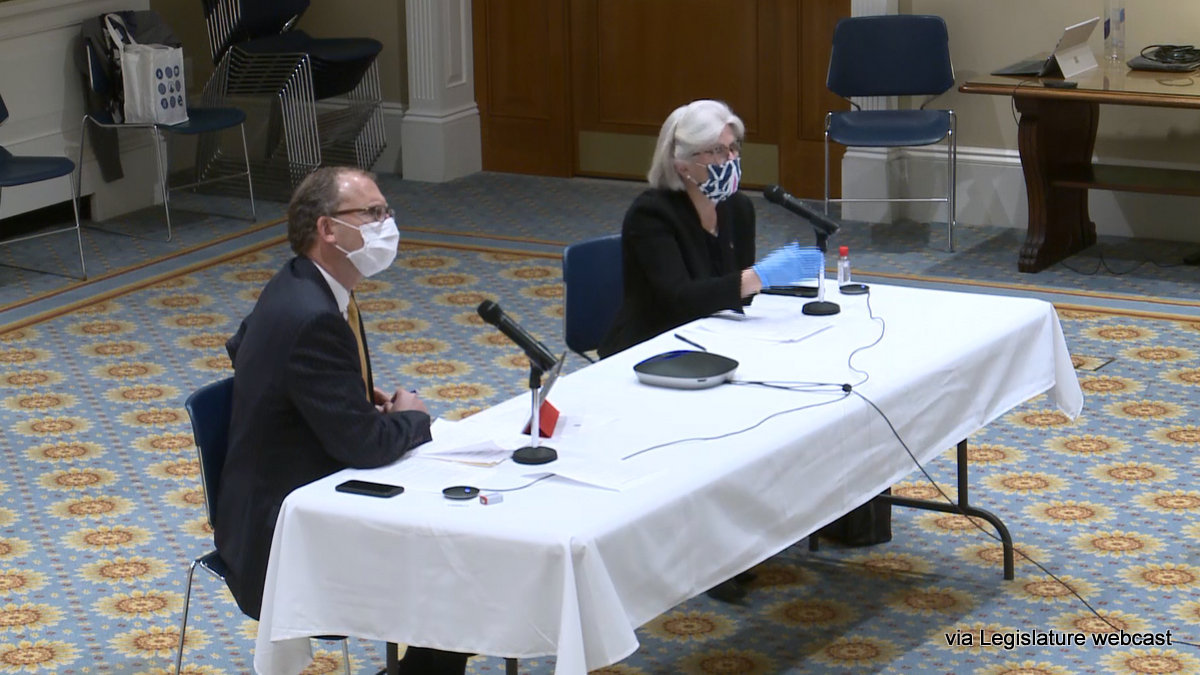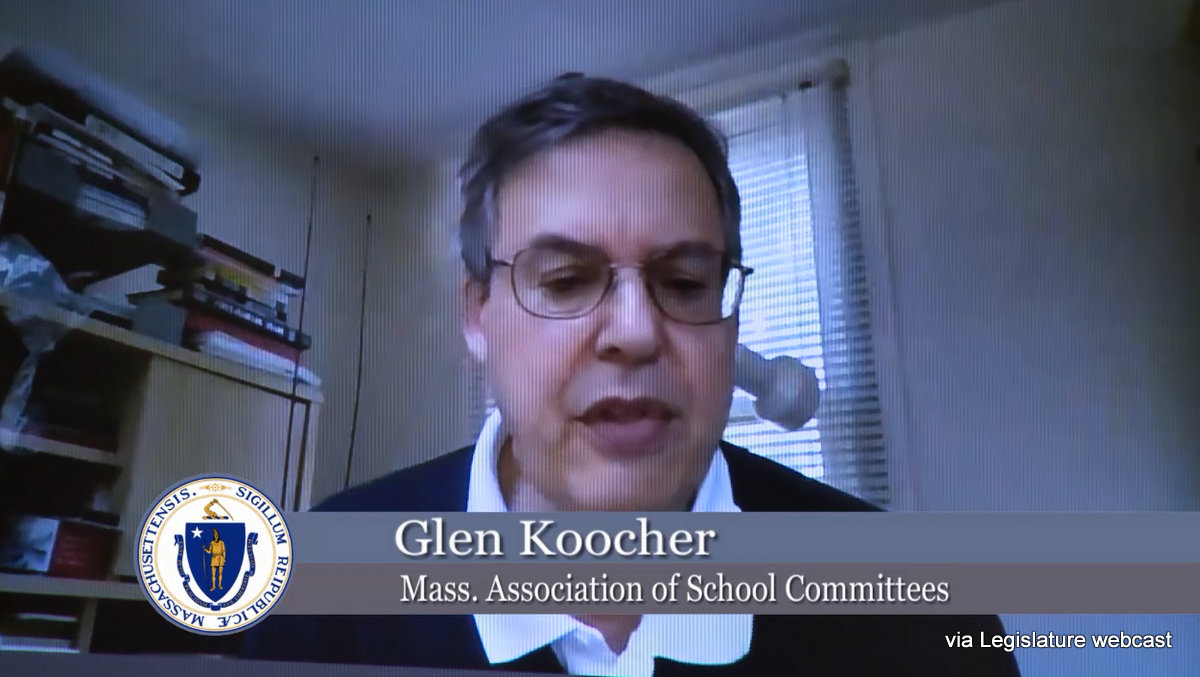Dire Outlook for School Budgets Across CommonwealthBy Stephen Dravis, iBerkshires Staff
02:36AM / Friday, May 15, 2020 | |
 Sen. Jason Lewis, D-Malden, and Rep. Alice Halon Peisch, D-Wellesley, conduct Wednesday's virtual hearing of the Joint Committee on Education. Sen. Jason Lewis, D-Malden, and Rep. Alice Halon Peisch, D-Wellesley, conduct Wednesday's virtual hearing of the Joint Committee on Education. |

Glenn Koocher of the Massachusetts Association of School Committees testifies before the committee on Wednesday.
BOSTON — School districts across the commonwealth face a "dreadful" situation with regard to their fiscal year 2021 budget, legislators were told on Wednesday.
The Joint Committee on Education took more than four hours of testimony from state education officials, school administrators, teachers, parents and other stakeholders in an virtual oversight hearing on "Remote Learning and the Status of K-12 Education."
Although much of the testimony centered on the commonwealth's and districts' efforts to implement remote learning plans on the fly in the wake of March's closure of school buildings, the conversation frequently strayed to looking at the road ahead for public schools.
It was clear that much is unknown about the effects of the COVID-19 pandemic on school finances, but two things are known: Recovery from the virus will increase districts' costs, and the stunted economy will reduce districts' revenues.
Already, in the Berkshires, Pittsfield Public Schools are planning to make $1.4 million in cuts to their fiscal 2021 spending plan.
"Budgeting, of course, is a key function of school committees, in collaboration with our municipal officials and superintendents," said Glenn Koocher, the executive director of the Massachusetts Association of School Committees. "This is a very dreadful situation. We just don't know what's going to happen.
"We are concerned about losing our best people. We are concerned about those districts that negotiated collective bargaining agreements before the virus. We've encouraged everyone who is engaged in trying to get a contract negotiated now to look no further than one year and to be very conservative with how they view their spending obligations."
At the state level, the commonwealth, which distributed $5.2 billion in Chapter 70 aid to schools in FY20, is seeing its FY21 budget squeezed by losses in income tax revenue because of high unemployment and mounting costs to fight the pandemic and support victims of the crashing economy.
Locally, municipalities also are incurring costs from the pandemic, and they are losing revenue from rooms and meals taxes and the cannabis tax receipts that some cities and towns already were building into their revenue structure.
"We have a meeting of all of our superintendents, assistant superintendents and business officials [Thursday]," said Tom Scott, the executive director of the Massachusetts Association of School Superintendents. "We have some communities that are talking about a 25 percent reduction and actually have built a budget on that. I think that's a pretty extreme position to take, but there are some who have gone to that extreme.
"What we have talked about a lot is talking about a level service budget to maybe looking at something in a 5 to 10 percent [cut]. … What I anticipate is that we won't have anything concrete until maybe July at best."
In the meantime, Scott said, school districts are going to be faced with some difficult decisions.
"This may require a reduction in force," Scott said. "We may see a loss of personnel. That's one of the areas our legal counsel will be talking about with superintendents coming up: How do you think about that? How do you deal with that?
"In this climate, with everything that is going on, the idea of making reductions in staff is very painful. But it's an eventuality that we may have to face, so we need to prepare for it."
Decreased revenue likely is one struggle that school districts will face.
Increased costs is the other.
Several of those testifying at Wednesday's hearing mentioned that when schools do reopen, social distancing guidelines likely are still to be in place. That means, potentially, more school bus runs to spread out children instead of putting them two to a seat, and staggered school hours that don't put all the students in the building at the same time.
It also means greater costs incurred for more regular thorough cleaning of classrooms -- both labor costs and material costs. It means a greater need for social/emotional supports for children who may have been traumatized by the pandemic and more individualized or small group instruction for students who may need additional help catching up after losing three months of classroom instruction. It means supplying personal protective equipment for staff and, possibly, children.
"We have schools that don't have nurses," Scott said. "It seems to me that you're going to have to have a nurse in every school. How do you deal with that question in and of itself?
"The issues and questions are continuous, and it's overwhelming when we start to dig into it and try to figure it out. … Superintendents are getting pressured and asked, ‘How are you going to open school?' We try to say to them, 'The state's working on this. We'll try to do this as standardized as we can. … Health issues are going to drive a lot of this.'
"But there are going to be some serious potential costs to this."
And there is the serious possibility that the current school closure will not be the last school closure attributed to the novel coronavirus. School officials already are thinking about the possibility of a so-called "second wave."
"All of this will likely affect what instruction will look like as well," Secretary of Education James Peyser told the legislators. "That means some of the lessons we are learning this spring, both positive and negative, will need to inform how we approach teaching and learning in September.
"There's no question that remote learning will be a much larger factor in planning for the next school year. Even if we were able to start school in a quasi-normal fashion, we have to be prepared for the possibility that in-person education will be interrupted again."
As for the remote learning plans already implemented this spring, results have been a mixed bag, according to the testimony on Wednesday. While some youngsters may have thrived in an independent learning environment, others have struggled, and, in the extreme, some have disengaged entirely, officials said.
State and local officials both praised the efforts of Massachusetts' teachers to reinvent their lesson plans and learn new ways of reaching students.
"Teachers have been forced to teach using tools and platforms for which they have received little or no training, and they're not complaining," said Amy Looman, the principal of Colrain Central School in the Mohawk Trail Regional School District. "Teachers were trained to provide instruction in person using a variety of tools and technology, but that's very different from online learning.
"My teachers are resilient, and because of their dedication to their students and their work, they're learning as they go and adapting, but it is far from easy."
Nor is it easy on families, many of whom are struggling to provide children with adequate internet access and/or access to enough devices in families with multiple students. Colrain's Looman and Kim Stevens, a parent in the Colrain district, were invited to testify to the Joint Committee by state Sen. Adam Hinds, D-Pittsfield, who wanted to show his colleagues the particular challenges of remote learning in rural communities.
And even when the technology works, the challenge persists for teachers who are trying to walk the line between giving enough work for students to stay engaged and not giving so much work that they are overwhelmed.
"We are learning and adapting as we go along," said Scott of the superintendents' association. "We know there is great variability in expectations from home. Some parents don't understand why we can't provide a regular day of instruction while others are not sure they can continue with the daily demands of home life and provide education support for children. Parents are understanding the complexity of good teaching: when to press the gas and when to ease up.
"I don't think we're ever going to reach that satisfactory point for all. … When I was a principal, oftentimes, I would ask parents about homework: Are your children receiving not enough homework, or are they receiving too much homework? Oftentimes, I would receive 50 percent of the parents raising their hands for one and 50 percent of the parents raising their hands for the other. This is not dissimilar to that."
| 
 MEMBER SIGN IN
MEMBER SIGN IN
 MEMBER SIGN IN
MEMBER SIGN IN